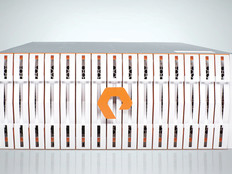What Are the Best Resources to Run in a Private Cloud?
Once a private cloud is up and running, IT managers have some fundamental decisions to make: Which applications and services are best suited for this dynamic environment?
Truth be told, not all applications are a good fit. The factors that can make a CIO or IT director think twice about moving a specific program to the cloud include performance requirements, the complexity of the workload and how highly customized an application needs to be for particular use cases.
“We find that approximately 30 percent of a large organization’s application portfolio is best served by running on dedicated, physical hardware rather than in a cloud,” says John Humphreys, vice president of sales and marketing for Egenera, a maker of cloud management software. “A large number of legacy applications that are home-grown have not been tested or don’t qualify for virtualized environments.”
How can an IT team that’s setting a private cloud migration strategy decide which apps make the cut? The key word in that last sentence is “strategy.” A sound migration strategy will include inventorying all current applications; identifying the potential cloud-ready apps; and prioritizing apps for their move from the data center’s traditional IT environment to an internal private cloud.
The Factors
At the top of the consideration list when evaluating cloud readiness is each application’s interface. The IT team must determine if the interface is compatible with use in a private cloud. The best interfaces are simple and static versus those that change frequently. Frequently changing interfaces will require changes to the organization’s internal cloud processes, driving up cost and driving down convenience.
The IT team will also want to assure that cloud-candidate applications can run effectively on the standardized server platforms, images and commodity hardware that are the cornerstones of private clouds. Complex applications, such as large-scale enterprise-level resource-planning systems, for instance, are typically designed to run best using dedicated resources. Moreover, any mission-critical application that supports core operational processes might need to run on dedicated resources.
In addition, consider grouping applications that have similar service-level agreement (SLA) requirements. Wide variances in SLAs diminish the standardization required for well-run clouds and add to deployment and on-going management costs.
Applications that require high degrees of customization and are continuously targeted for upgrades and improvements may not be suitable for deployment in an internal private cloud. The continuous rate of change would prove taxing on the dynamically provisioned, self-service model.
Another possible deal breaker when it comes to private-cloud appropriateness are legacy applications that pull information from multiple databases. It also may be best to cross off applications that will need modification or even a full re-architecting of their internal design to benefit fully from the cloud’s elastic computing model.
Failure to think about and plan for the need to adapt applications for use in the cloud could negate the benefits of migrating these workloads.
Good Choices
A valuable tack when evaluating applications for private clouds is to group services by function. This approach can quickly uncover good cloud candidates.
“We see a trend toward specialized private cloud services that can add value versus trying to take on the full-fledged private cloud,” says John Treadway, senior vice president at consulting firm Cloud Technology Partners. One example is the development and testing environment, which Treadwell calls the low-hanging fruit of private cloud use cases. “A private cloud can make resources much more accessible to the development staff.”
Speed in provisioning testing resources is the chief advantage that clouds bring over traditional IT sandboxes. In the past, programmers may have had to temporarily commandeer idle production capacity for such needs. This approach often limited the test bed available to evaluate new code. Conversely, even if funds were available to build out the development and testing environment, the process could be delayed by extended purchasing and implementation cycles. The results? The development staff had to make do with less than optimal resources, and end users had to endure delays in obtaining needed services.
But pools of resources and dynamic provisioning available through private clouds gives developers a way to scale up resources for projects as needed and then scale back once new code goes into production.
Other special-purpose private clouds include virtual desktop infrastructure implementations, Big Data solutions and collections of relational database resources. For example, an organization might opt to group together database appliances that come as integrated boxes with database software, hardware and associated components. IT managers can then add private cloud management and automation tools to the appliance collection for a pool of databases for enterprise-level applications to use.
Services Orientation
Some cloud watchers say decisions about what to run in a private cloud don’t have to conform to hard and fast rules.
“Organizations may want to consider designing services for specific purposes versus designing clouds for certain purposes. It’s a subtle distinction,” says Edward Newman, senior director of cloud and IT transformation for EMC’s global services unit. “The idea is you have one cloud that provides multiple services, some of which may be at the infrastructure level, some at the platform level and others where applications get the full value out of the private cloud investment.”
Generalization versus specialization is another valid approach, Desai adds.
“If you are dedicating the private cloud to a specific application, you may not be taking full advantage of the technology,” he says. “The resources within a private cloud should be flexible enough to be used for a wide variety of scenarios, whether that’s development and testing or a financial services system.”








